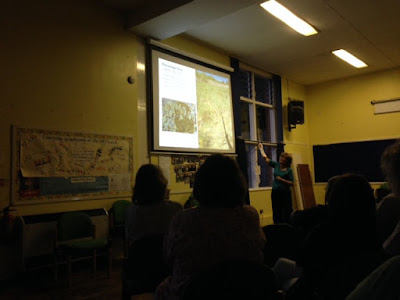Talk by Dr Judy Webb on Cothill Fen, Christ Church Hall, Abingdon, 6th September 2016
Earlier this year, we were approached by Dr Judy Webb, who offered to give a talk to Abingdon Green Gym on the work that we have been doing over the years at Cothill Fen, a site which is managed by Natural England. Judy is a professional ecologist and a county recorder of species for Oxfordshire, with a special love for fungi, invertebrates and flora and she oversees our sessions at Cothill Fen on behalf of Natural England. The Hall at Christ Church in Abingdon had been booked and invitations had been sent to interested parties and local societies, including Natural England, the Earth Trust and Abingdon Naturalists' Society.
The Green Gymmers who'd volunteered to help with refreshments and setting out the tables and chairs arrived early and a table with the Green Gym display board and leaflets was set up alongside another table displaying jars of Green Gym marmalade for sale. Eleanor had also kindly donated some jars of homemade chutney and made her delicious lemon curd to sell, which was a delightful surprise. All in all, we raised £28 from the sale of these goodies.
It was lovely to welcome everyone from Natural England, the Friends of Cothill Reserves, the Earth Trust and Abingdon Naturalists' Society, among others. Sally introduced Judy to a very attentive audience, who started her talk by giving a brief history of this special site, which is one of a number of related calcareous fens - an extremely rare habitat in England and Wales. Cothill Fen, the main site where we work, is also known as the Ruskin Reserve and was purchased in circa 1904 for the princely sum of £90 by Henry Willett, a friend of John Ruskin, at the behest of George Claridge Druce, a botanist who could see the value of this site. It forms part of the Cothill Fen group, including the adjacent Parsonage Moor (managed by BBOWT), Lashford Lane, Dry Sandford and the Frilford Heath Fens, including Two Pine Fen, all of which are SSSIs and Cothill Fen (including Parsonage Moor) also has the European status of SAC (Special Area of Conservation).
Judy then explained the geology of the Fens, which are fed by calcium-rich spring waters, and it is this that makes them so special. Sadly, over the years, the fens have shrunk - partly because of the encroachment of scrub, which dries the fenland, and partly because of man's interference - through gravel extraction, development and agricultural run-off - and the flora and fauna that have developed over millenia are now struggling to keep up with the pace of change. Hence the need for Natural England, with the help of the Green Gymmers, to keep cutting the reeds and removing scrub and cutting back the trees that are encroaching from the adjacent woodland. In the last few years, Natural England and BBOWT had removed the fence from between Ruskin Reserve and Parsonage Moor to enable Welsh Mountain Ponies to graze the fens (as they are rather partial to the fresh shoots of the invasive reeds).
It was wonderful to see Judy's selection of slides showing an array of rare plants, invertebrates and fungi, including the beautiful grass of parnassus, orchids, the southern damselfly, broad-bodied chasers and the delightful banded 'soldier' flies. Although the grass of parnassus has been sighted on Parsonage Moor, it has eluded Cothill Fen and Judy is hoping that perhaps at some stage in the future, the common sundew (a carnivorous plant) will make a comeback. Two Pine Fen on Frilford Heath Golf Course got a special mention, which is one of the sites where Green Gym has helped exceptionally during the week in the past couple of years, when the course is closed to minimise the risk of concussion from stray golf balls! It boasts the largest patch of sphagnum moss in the county and since we have been raking it, the number of orchids has visibly increased along with other fen plants, such as twayblade.
Judy reeled off the number and variety of species which are on the increase since Green Gym's involvement, particularly at Cothill Fen, and although the fen is not quite back to the same size as when it was purchased over a hundred years ago, we are gradually getting it back and the wildlife is responding, albeit hesitantly.
After a questions and answers session, we presented Judy with a bottle of organic wine as a thank you. Everyone then enjoyed a delicious selection of biscuits with tea and coffee served by Barry and Enid, Kate H, Carolyn and Lesley. The Green Gymmers did a sterling job serving refreshments, washing up and putting away tables and chairs before our time in the Hall was up. A few of us ended up in the nearby "Spread Eagle" for a well-deserved drink!
We came away with a great sense of pride and achievement and many of us were looking forward to the coming Saturday, when we would be back at Cothill Fen again to see for ourselves just what a difference we have made so far and continue our efforts to encourage the fenland flora and fauna to come back and thrive and, of course, to thank Judy for her enthralling talk, putting it all into context for us.
-Sally




Comments
Post a Comment